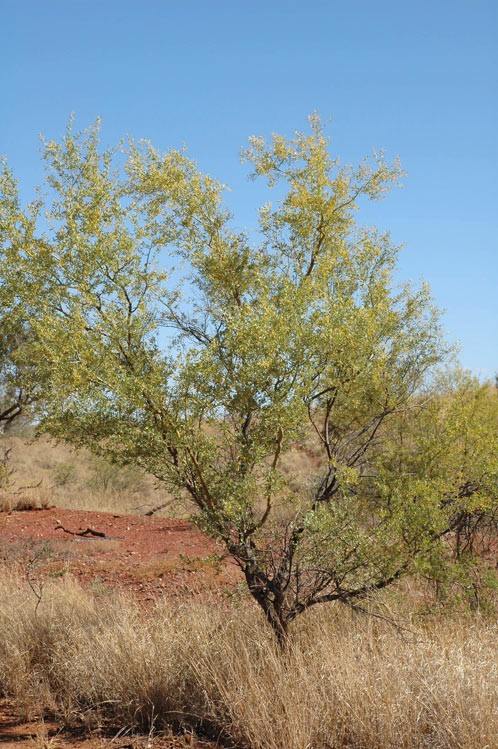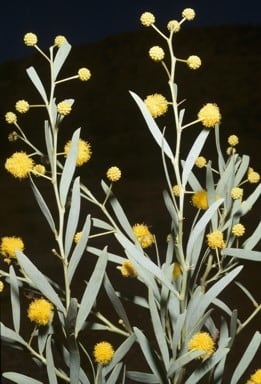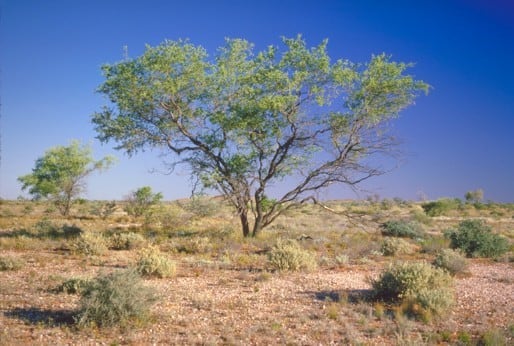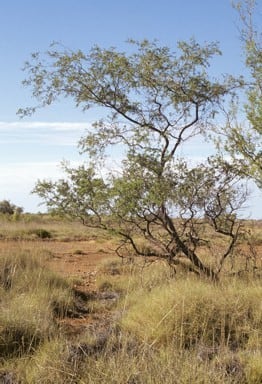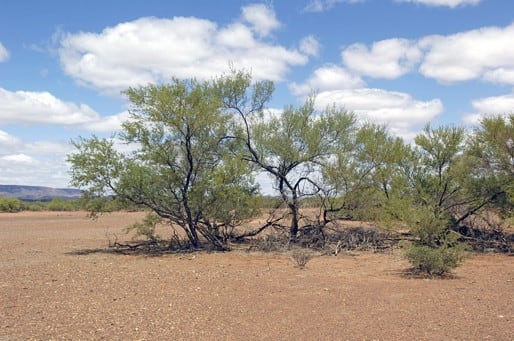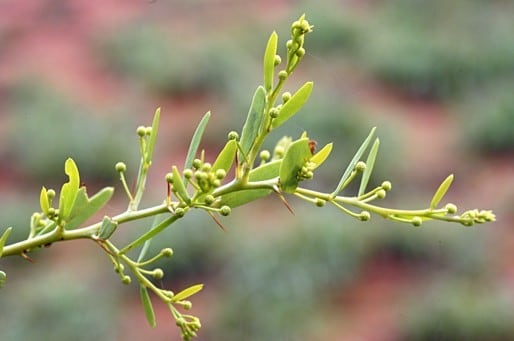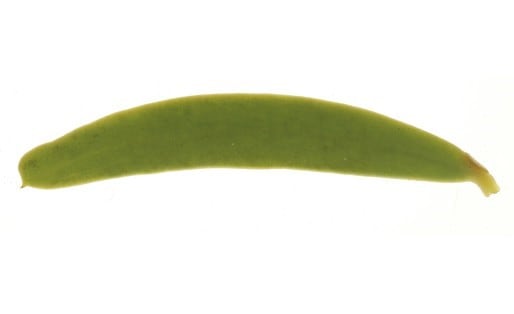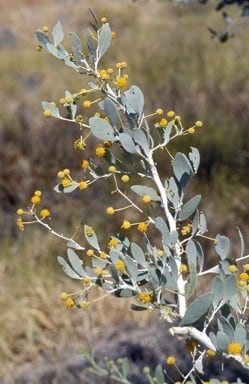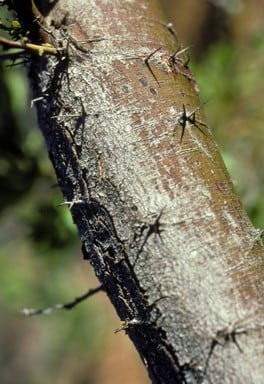Acacia synchronicia Maslin
WATTLE
Acacias of Australia
Common Name
Bardi Bush, Bramble Wattle
Family
Fabaceae
Distribution
Common from Shark Bay N to Port Hedland and E to Rudall R., and in the southern Kimberleys, with scattered occurrences in the Cue–Yalgoo area, W.A.; also one collection from near Rabbit Flat Roadhouse, N.T., c. 100 km E of W.A. border.
Description
Somewhat straggly, openly branched, glabrous shrub or tree 1.5–4 (–6) m high, upper branches commonly bronze-coloured. Branchlets grey to light brown or greenish, often pruinose. Stipules spinose, commonly absent or infrequent on mature plants, 3–10 mm long. Phyllodes variable, elliptic to narrowly elliptic, ovate-elliptic or oblong-oblanceolate, infrequently narrowly oblong, 15–25 (–35) mm long, 3–7 (–11) mm wide, l:w = (1.5–) 3–7, normally grey-green to glaucous, subfleshy, smooth or finely wrinkled when dry; midrib and lateral nerves obscure or absent; gland 0–2 mm above pulvinus, rather prominent (normally 0.7–1.3 x 0.5–1 mm). Inflorescences simple, 1 or 2 per axil, initiated synchronously with phyllodes on new shoots; racemes rare; peduncles 1–2 cm long, with caducous bract near or above middle; heads globular, 40–70-flowered, golden. Flowers 5-merous; sepals free, narrowly spathulate. Pods oblong to narrowly oblong, to 4–5 cm long, (7–) 8–12 (–14) mm wide, chartaceous, flat but rounded over seeds along midline. Seeds transverse, ovate to elliptic, usually 4–5 mm long, ± dull, mottled black and yellow or light brown; funicle short, thick, aril small.
Phenology
Flowers mostly from Sept.–Dec.
Habitat
Grows along watercourses and on alluvial flats, mostly in shrubland. Sometimes a noteworthy nuisance plant and labelled a woody weed in parts of the Pilbara where it can form dense thickets which are impenetrable to livestock, see B.R.Maslin et al., Wattles of the Pilbara CD-ROM (2010) for discussion on utilization of this species.
Specimens
W.A.: 93 km from Halls Ck on road to Fitzroy Crossing, I.B.Armitage 166 (PERTH); near Mindi Springs, Hamersley Ra. Natl Park, C.Dawe 093 (BRI, K, PERTH); 57.5 km SE of Yalgoo towards Paynes Find, B.R.Maslin 4253 (PERTH); 42 km S of Onslow on Ashburton R., D.G.White 630805 (PERTH). N.T.: 3 km NW of Rabbit Flat, on Tanami Track [Rd], M.Hancock 459 (DNA, NSW, PERTH).
Notes
A member of the ‘A. victoriae group’, most closely related to A. robeorum which was treated as a narrow phyllode variant of A. synchronicia by B.R.Maslin in Fl. Australia 11A: 379 (2001). Acacia synchronicia was included in A. victoriae which differs especially in its normally racemose inflorescences with pale lemon-yellow heads of 15–30 flowers, and its phyllodes which are often longer with a generally smaller gland and more prominent midrib. A few Kimberley specimens are possibly intermediate between the two species.
Some plants from the eastern Pilbara (Marble S to Ethel Creek Stn) are generally more pruinose than those of typical A. synchronicia and also have broader than normal phyllodes (i.e. 8–10 mm wide with l:w = 2–3, compared with 3–7 mm wide with l:w = 3–7) (e.g. 6 km S of Nullagine on Great Northern Hwy, B.R.Maslin 5267, PERTH). The taxonomic status of this entity requires further study. It was called Acacia synchronicia (broad phyllode variant) in B.R.Maslin et al., Wattles of the Pilbara CD-ROM (2010), but is currently known under the phrase name, Acacia sp. Ripon Hills (B.R. Maslin 8460). The typical and broad phyllode forms of A. synchronicia are sometimes sympatric and intermediates appear to occur. The broad phyllode form is superficially similar to A. glaucocaesia which is distinguished by its predominantly racemose inflorescences, paler yellow heads and more thinly textured phyllodes with a smaller basal gland.
FOA Reference
Data derived from Flora of Australia Volumes 11A (2001), 11B (2001) and 12 (1998), products of ABRS, ©Commonwealth of Australia
Author
B.R.Maslin
Revised by B.R.Maslin
This identification key and fact sheets are available as a mobile application:
URL: https://apps.lucidcentral.org/wattle/
© Copyright 2018. All rights reserved.

